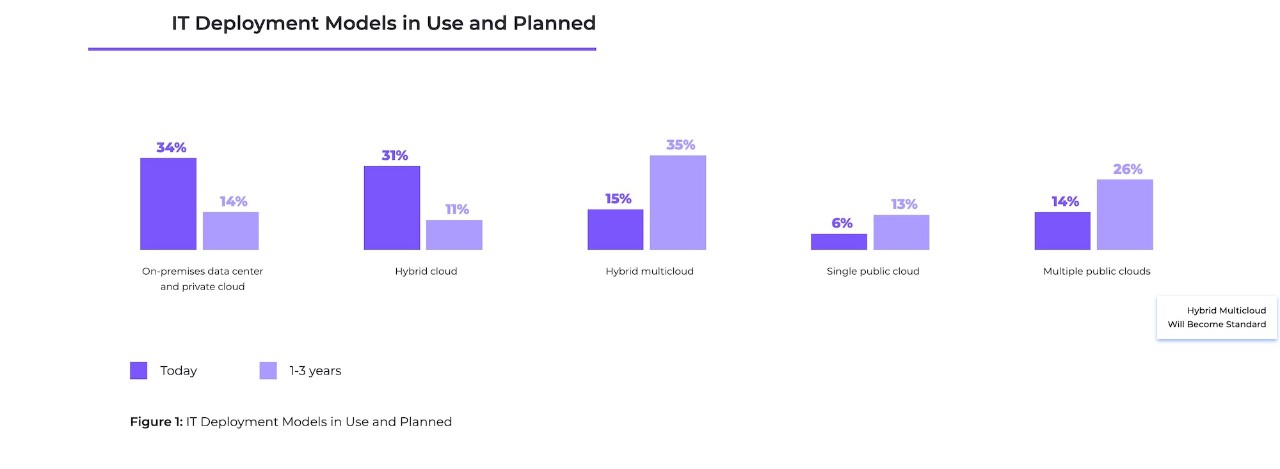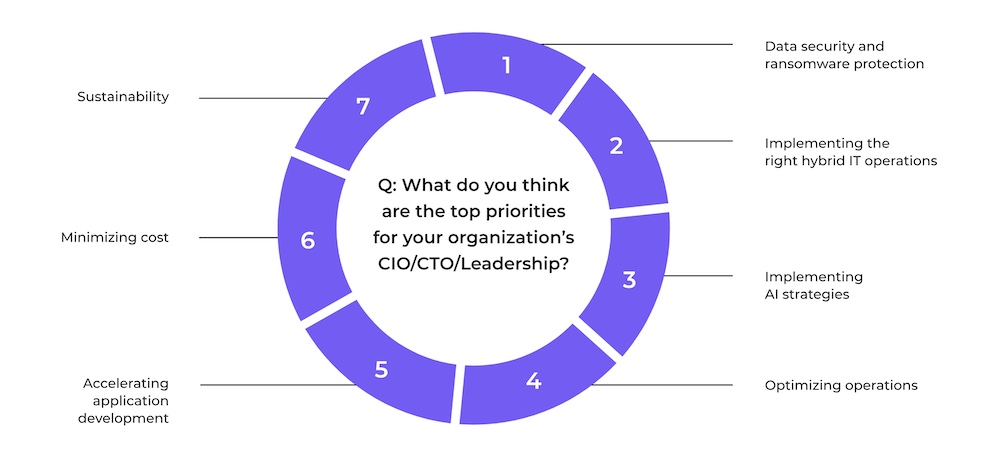Business resiliency. Sustainability strategies. Operational flexibility. Data protection, governance and compliance. These and other factors such as onboarding artificial intelligence (AI) capabilities are driving more organizations to build their future on hybrid multicloud, which has become “the de facto infrastructure standard,” according to findings from a recent survey of IT decision makers from around the world.
The 6th Annual Nutanix Enterprise Cloud Index (ECI) showed that a vast majority of organizations are turning to hybrid multicloud infrastructure because it allows them to run applications in a private data center, at the edge or in a public cloud service and move between them, whenever it makes sense.
“Whether it be because of AI, sustainability, or security imperatives, IT organizations are facing ever-increasing pressure to modernize their IT infrastructure quickly,” said Lee Caswell, senior vice president, product and solutions marketing at Nutanix, when the ECI was released.
The ECI report, by research team Vanson Bourne and sponsored by Nutanix, is based on survey responses from 1,500 IT, DevOps, and platform engineering decision makers worldwide identified the need for new infrastructure to support AI, and revealed trends around ransomware, balancing security with innovation, and building IT sustainability into everyday practices.
“Over 80% of organizations believe hybrid IT environments are most beneficial to their ability to manage applications and data,” the ECI stated. “Most importantly, this is now becoming an executive priority, with nearly half of respondents noting that implementing hybrid IT is a top priority for their CIO.”
Findings showed that hybrid multicloud is the preferred IT model, but it doesn’t come without challenges, explained Caswell.
“More environments mean more complexity,” Caswell wrote in a blog post. “Leveraging all of these environments also means more providers, with a variety of different toolsets and processes, and a range of varying skillsets needed to adequately manage data and workloads from one environment to the next.”
Building The Future on Hybrid Multicloud
In recent years, many organizations have adopted a public “cloud-first” strategy, eager to take advantage of the many benefits of public cloud computing. Cloud computing grew so alluring that some industry watchers wondered if there was a future for on-premises data centers. However, 80% of 2024 ECI survey respondents stated they that hybrid IT environments give them the greatest flexibility to manage applications and data.
May IT teams experienced a rude awakening after realizing the mounting costs of relying on public cloud service, according to Rajiv Ramaswami, President and CEO of Nutanix.
“People have become much more circumspect about what goes in the public cloud,” Ramaswami told an audience attending the .NEXT conference in May 2023.
“It isn't as easy to take everything you want to the public cloud. It can be very painful for lots of applications [that] will need refactoring and potentially re-platforming. … And for those new apps that you're building, it's great. It's an easy on-ramp. But once you start running it at scale, … the costs start climbing up.”
A similar rude awakening drove David Heinemeier Hansson and his team at 37signals to “move seven major applications out of the cloud” in 2023, which he documented in a series of widely read blog posts. He even pointed out that X (formerly Twitter) optimized its use of cloud service providers and began doing more on-premises, which reduced monthly cloud costs by 60%, cloud data storage size by 60%, and cloud data processing costs by 75%.
“If the money matters – and when does it not? – I urge you to do your own math,” Hansson wrote in June 2023. Consider whether you have a service that really benefits from constantly scaling the capacity up and down. Then have a serious look at what your own cloud exit could look like.”
The ECI showed that many are taking a “cloud smart” approach to managing applications and data, as 46% of respondents said they've already implemented a hybrid cloud or hybrid multicloud IT infrastructure. The report showed that the use of hybrid multicloud is could double over the next three years.
Organizations want deployment flexibility and see value in different infrastructure types for certain use cases or data management needs, according to Caswell.
“‘Flexibility to run solutions across clouds and on-prem’ was the number one driver in hybrid multicloud or hybrid IT adoption,” he said. “Hybrid multicloud delivers that flexibility and allows organizations to optimize workload placement.
AI Is Driving Enterprises to Modernize Infrastructure
AI is swiftly becoming another “must-have” for IT organizations. ECI respondents said that “increased investment to support AI strategy” was their number one priority. Because 37% of respondents indicated that running AI solutions on their existing infrastructure would be a serious challenge, investment in IT modernization came in as a close second priority.
“It turns out [AI is] actually the ultimate hybrid cloud app,” said Induprakas Keri, senior vice president and general manager of Hybrid Multicloud for Nutanix. “All the training happens in the public cloud. The data center is primarily about enrichment and refinement, and then all the inference happens at the edge.”
Speaking of the edge, the ECI report found that strengthening their edge strategy will be an important priority for 90% of organizations in the coming year. And 72% of respondents claim they will boost investment in the edge through the year. AI is almost certainly a driver of this urgency to modernize infrastructure and build capabilities into edge deployments, as real-time processing and data access at the edge are critical to many AI projects.
AI also requires access to and processing of massive volumes of data – and generates high volumes of data itself – so it makes sense that 93% of ECI respondents acknowledge the critical importance of improving visibility into where all of their data resides. Nearly half of respondents (47%) say that lack of adequate visibility over where their data is located is a serious data management challenge today.
As AI becomes more ingrained in the enterprise ecosystem, organizations will continue to feel the need to modernize infrastructure to support its hefty demands.
Ransomware Defense, Innovation and Sustainability
Throughout the ECI report, it is clear that today’s enterprises are striving to prepare their IT infrastructures to support growing demands and business-critical needs.
When it comes to data protection and the threat of ransomware, for example, 78% of enterprises are actively increasing investment in security solutions to protect against ransomware and other attacks on their data and applications. In fact, respondents ranked ransomware protection and data security as the biggest data management challenge for their organizations.
The threat is very real and so are the repercussions when an attack occurs. Over 70% of respondents who experienced a ransomware attack said it took days or even weeks to get operations fully restored. While there isn’t a single silver bullet to protect against ransomware, the best approach is multilayered security that can help organizations prevent, detect, mitigate and recover from attacks. Part of that is maintaining flexibility across the IT infrastructure to move workloads around as needed – and hybrid multicloud infrastructure delivers that flexibility.
Flexibility to place data and workloads where they’re needed also plays an important role in allowing organizations to balance data security and innovation. In fact, 95% of enterprises reported moving applications from one environment to another over the past year, specifically to aid either security or innovation.
Over a third of organizations, however, said that migrating applications across their existing infrastructure is a significant challenge.
Finally, sustainability remains a top priority for 88% of respondents’ organizations. To improve sustainability, more than half of respondents modernized their IT infrastructure to make it more efficient and optimize operations. Researchers called this a “fascinating result,” primarily because of its direct impact on the IT infrastructure market.
Hybrid Multicloud Is Maturing Rapidly
As enterprises seek to increase flexibility across their IT infrastructure and modernize to support advanced, evolving technologies such as AI, they will ultimately need to embrace a hybrid multicloud model. To make the most of the model, however, ECI researchers say it will be critical for organizations to deploy hybrid multicloud solutions that make their disparate environments interoperable and capable of “universal data management, protection, security, and monitoring tools.”
Over half of ECI respondents admitted that their hybrid multicloud environments aren’t fully interoperable. The report warns that “a lack of data and application interoperability solutions can result in costly security breaches, data loss events, resource utilization overruns, or redundant operations. This makes a unified hybrid multicloud, with a common cloud operating model across environments, key to success.”
Erin Poulson is a contributing writer who specializes in IT and business topics.
Ken Kaplan contributed to this story.
© 2024 Nutanix, Inc. All rights reserved. For additional information and important legal disclaimers, please go here.


















